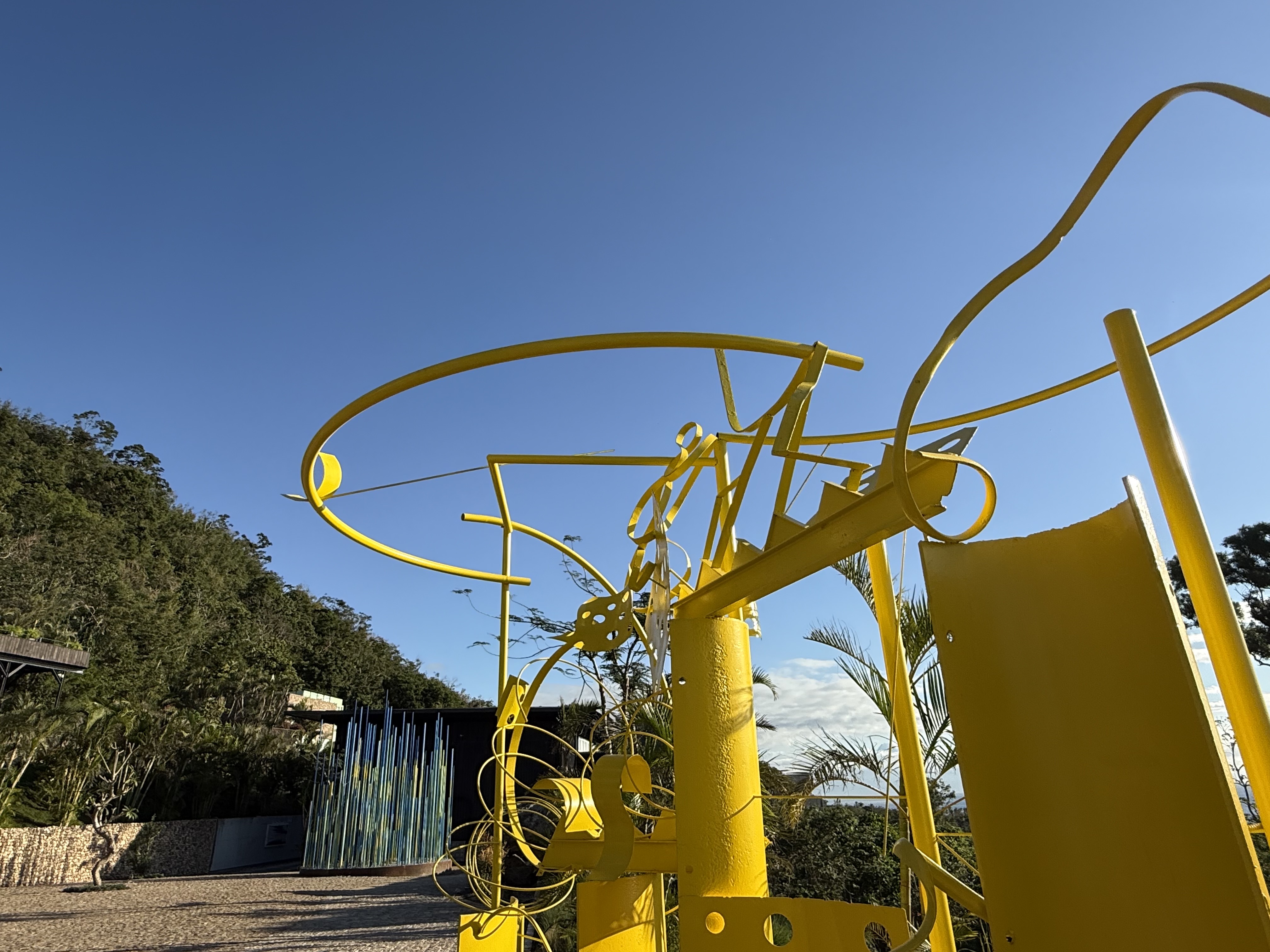
In the summer heat of Taitung, the sun peeks over the horizon, baking the entire eastern coastline. The Paul Chiang Art Center feels like an opened paint box, warm air mingles with the scent of sun-drenched grass. In the plaza, visitors raise blue Pisirian 13-33 umbrellas, frangipani blossoms bloom one after another, and fountain grass extends its slender flower spikes, swaying gently in the breeze. The fragrance of the Formosan mistflower attracts butterflies fluttering in circles.
Paul Chiang considers this art center the most complete work of his lifetime. What he hopes visitors see is not a series of individual pieces, but an immersive spatial experience. Here, painting, sculpture, architecture, light, and nature come together as a shared spatial language.
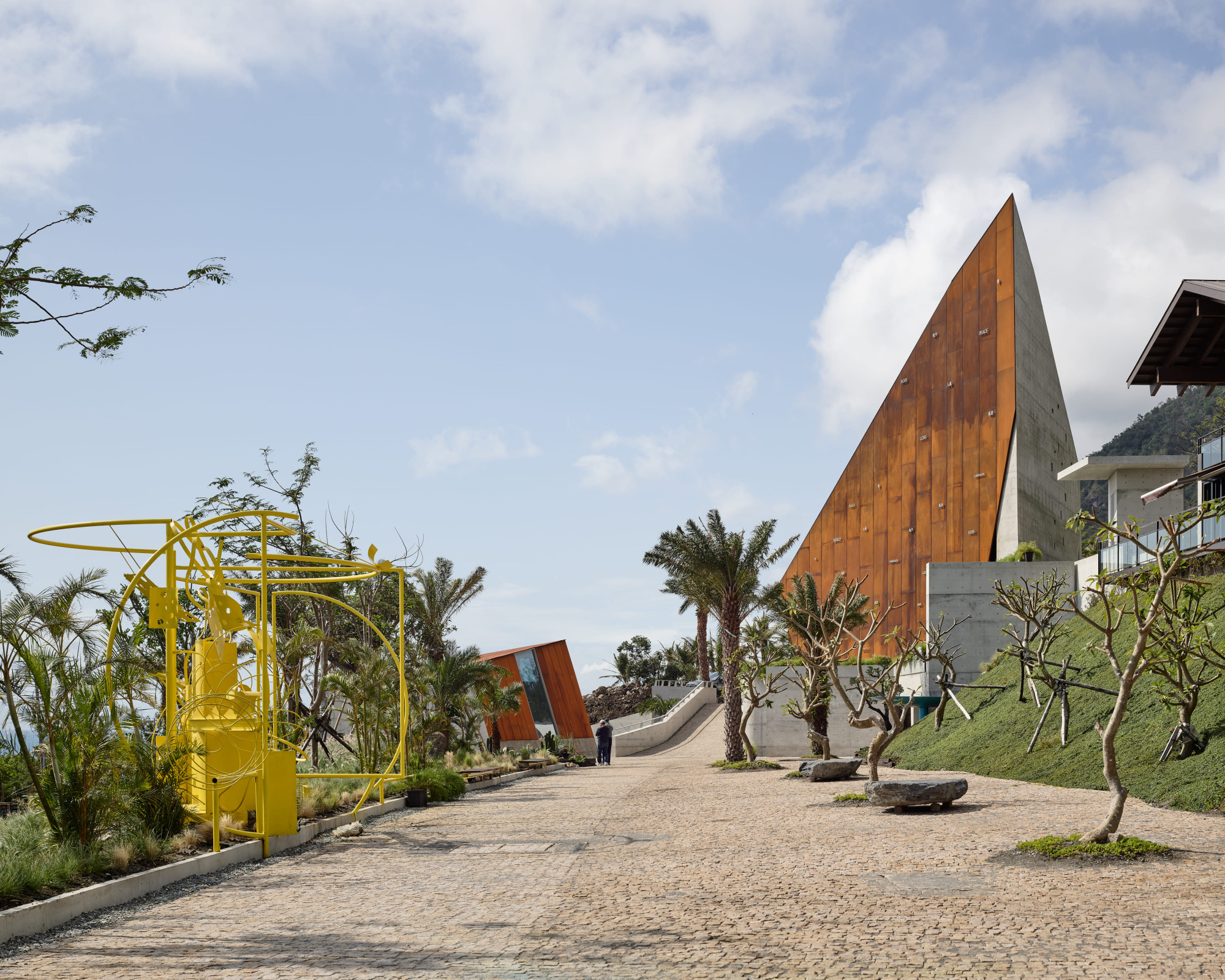
Many people wonder, when did an artist long devoted to abstract painting begin working in three-dimensional forms? Chiang laughs and says, “It’s in my DNA.” He had been interested in sculpture since high school, and after graduating from university and moving to Paris, he studied in a sculpture studio. “I’ve never been content with just painting on a flat surface, I always wanted the work to step out of the canvas.”
From a young age, Chiang was deeply drawn to the spatial atmosphere created in Alberto Giacometti’s sculptures. This fascination led to his steel sculpture Farm House, completed during his residency at Tung Ho Steel Enterprise. In 2020, his Jinzun series, exhibited at the Taipei Fine Arts Museum, used crumpled paper towels he had used to wipe paint from his brushes to create spatial dimensions on flat surfaces, and iron wire and metal parts to explore structures of presence and absence. In 2022, he assembled construction debris into Perish and Henry at the Taitung Art Museum. In 2023, at the Kaohsiung Museum of Fine Arts, his large-scale installation Afternoon of the Faun 23-00 used translucent corrugated panels as its base. Though his materials constantly evolve, the core remains unchanged – he persistently explores how materials can converse with space and with nature.
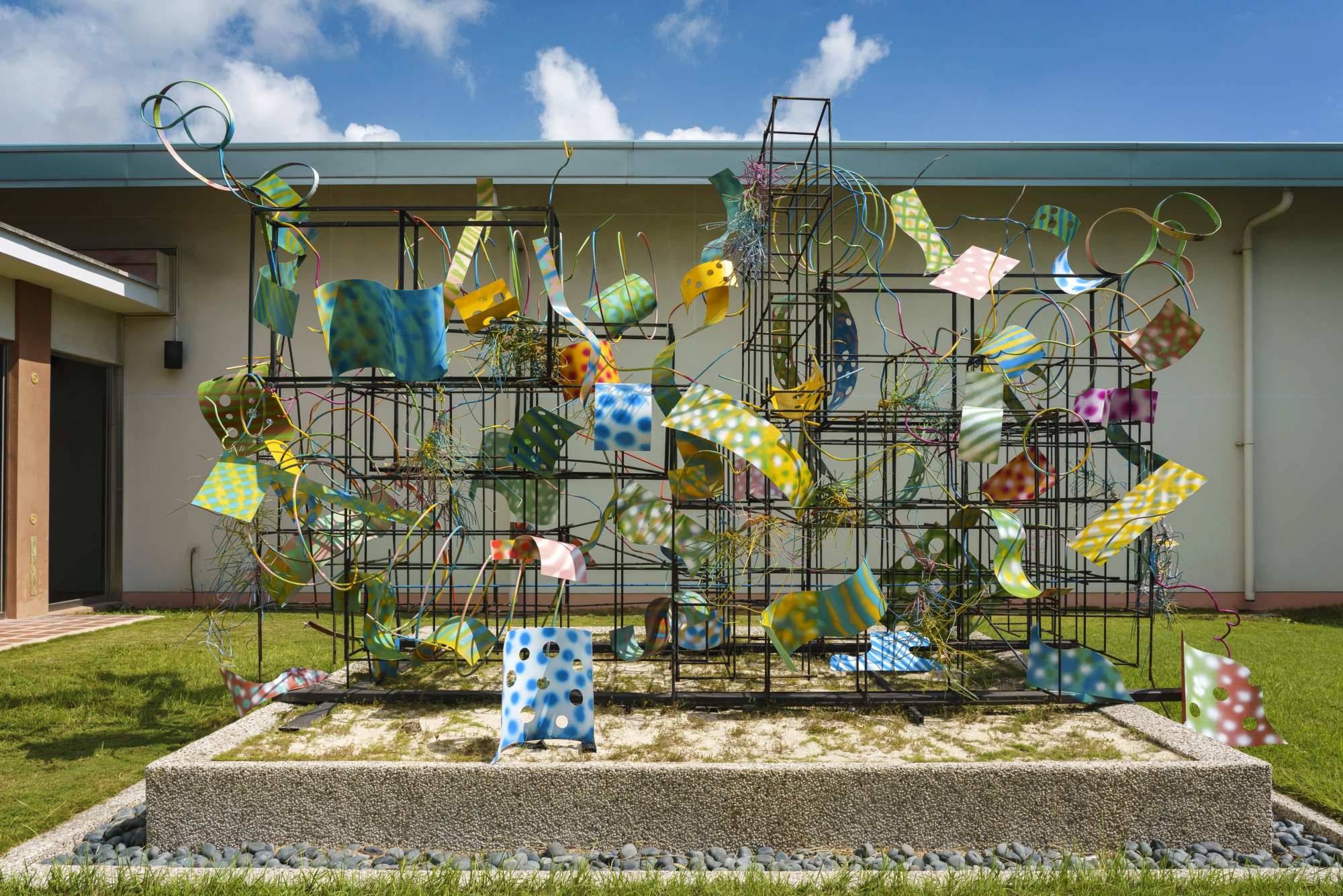
Architect Yu Han Michael Lin, who designed the art center, notes that Chiang possesses a remarkably strong spatial sensitivity. In the inaugural exhibition Light, Beauty and Purification, curator Fumio Nanjo selected Chiang’s works Untitled 75-01 and Untitled 75-02 from the 1970s, which already demonstrated his efforts to break through the flat plane and explore a spatial vocabulary. Today, this art center finally gives him more opportunities to realize the three-dimensional language that has long lingered in his mind.
The Fountain and Spatial Curves
Amid the scorching heat of midsummer, Chiang designed a circular, light-blue fountain at the entrance plaza of the art center to bring a sense of cool, flowing energy into the space. “I wanted people to hear the sound of water and see refreshing colors and forms the moment they enter – that’s why I chose this shade of light blue,” he explained.
This particular light blue is very pale, carrying a luminous, translucent quality. To achieve the ideal shade, the collaborating manufacturer conducted multiple test sprays and adjustments. The fountain features three water modes – mist, direct stream, and spray automatically cycling every hour. These shifting forms sketch out different rhythms of curved lines in the air, visible and audible, adding a dynamic sensory layer to the art center’s atmosphere.
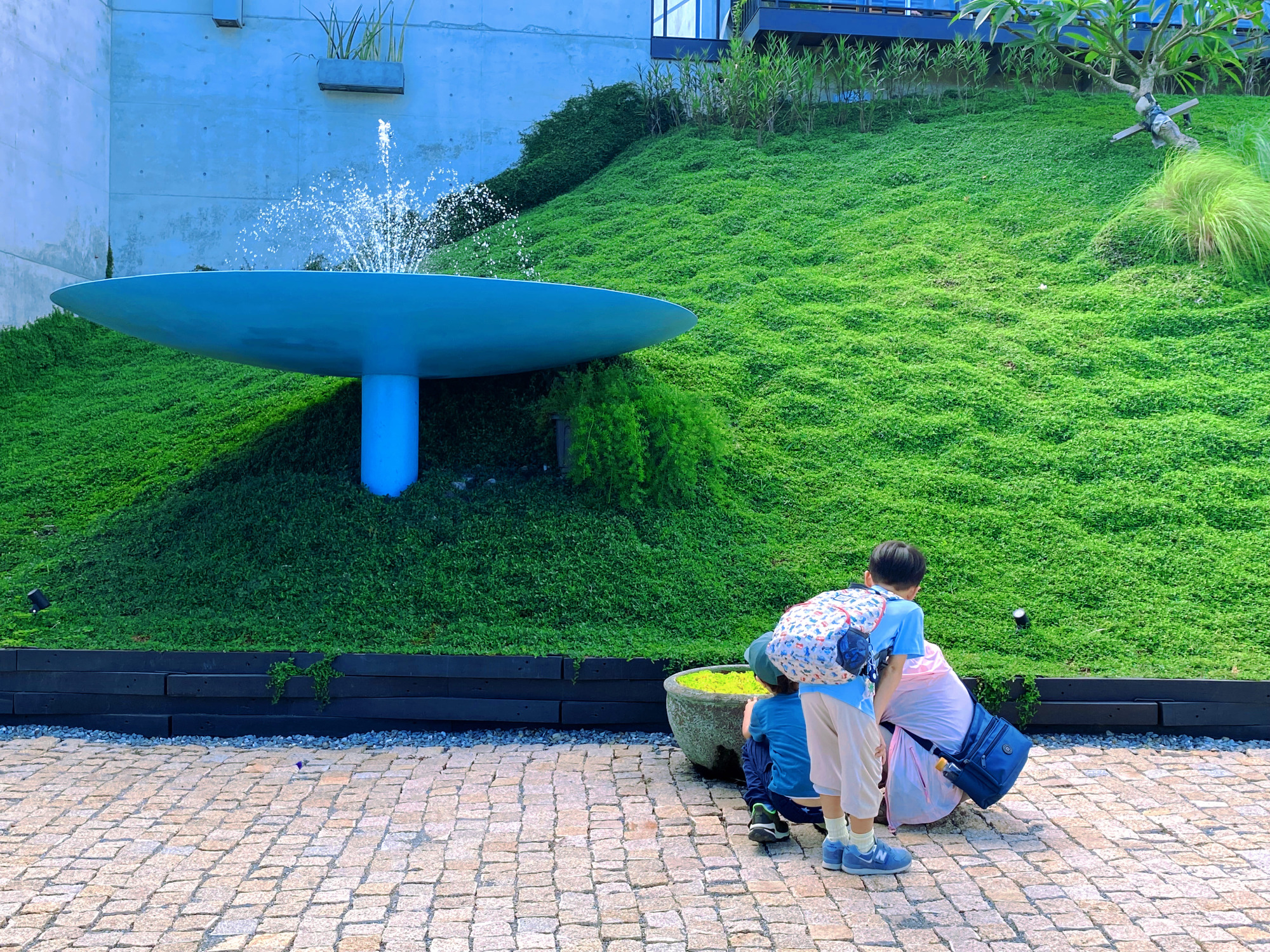
After visiting the art center, a fourth-grade student wrote a letter saying that when he looked down at the fountain from Café Debussy on the third floor, the sound of the water surprisingly seemed to come from above. It turned out that the structure of the elevator canopy on the third floor reflected the sound, creating the illusion that the water was falling from the sky. This subtle auditory misperception transformed the fountain from a mere installation into an engaging sound experience.
The circular design was no coincidence. From the cactus planting area, flower bed arrangements, elevator canopy, and the drinking fountain in the reception center, to the form of the outdoor sculpture Afternoon of the Faun 25-01, circles appear repeatedly throughout the center, forming a kind of visual language. These curves interact with the straight lines of the exposed concrete architecture, like pauses in the spatial rhythm, softening the geometry and drawing everything closer. Through order and rhythm, Chiang makes the forms of the art center approachable and harmonious.
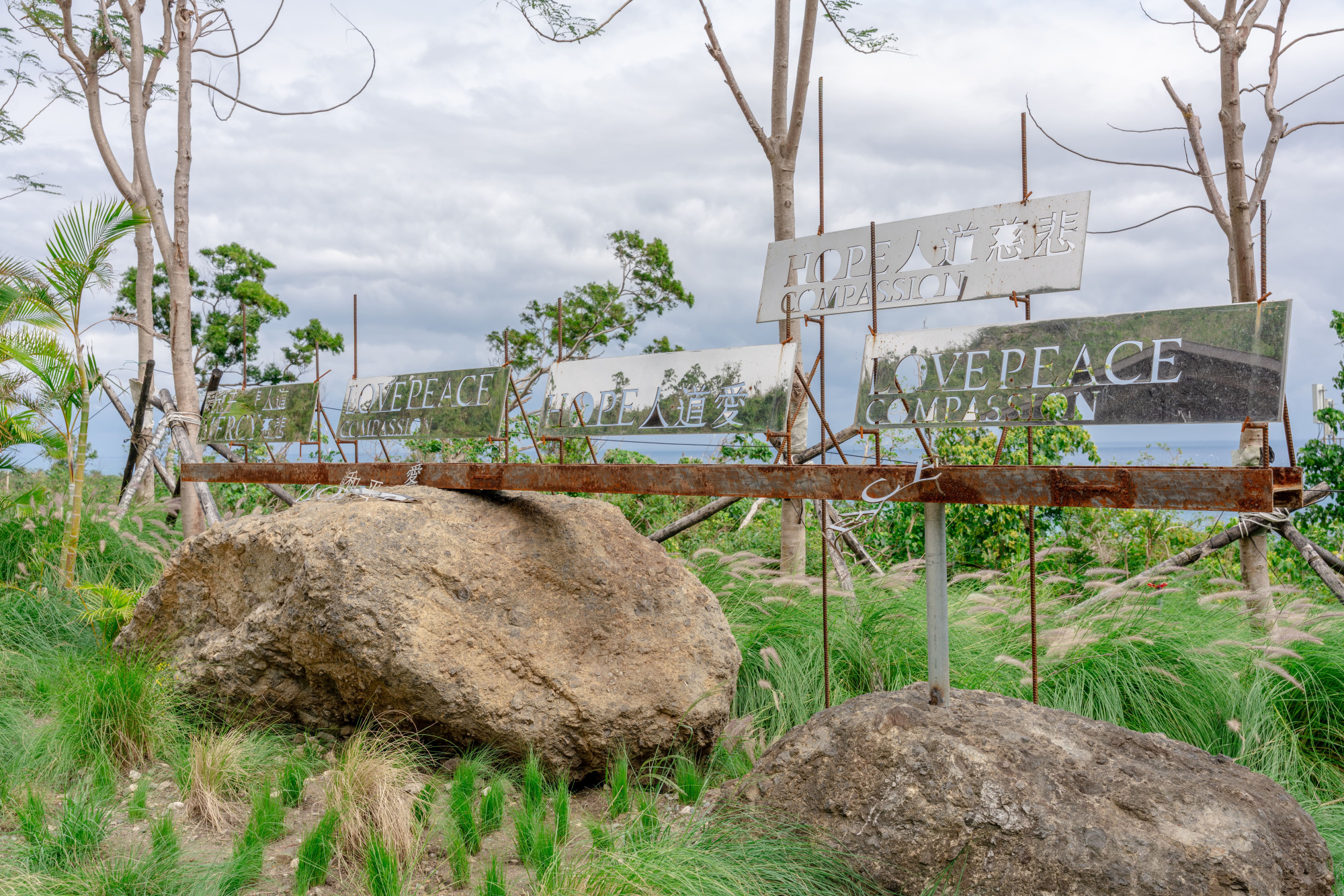
Virtual and Real
The outdoor sculptures in the art center are not pre-designed works built strictly to plan. Instead, they are created through Chiang’s process of observing and waiting, responding to the land’s contours and natural surroundings, then slowly transforming those ideas into tangible forms within existing site conditions and regulatory constraints. “You work with what you have,” he says. His creations are constantly adapted to the environment, a practice that aligns with his decades-long creative habit of staying fluid and responsive rather than rigid.
The sculpture Virtual and Real is situated atop a large boulder. Above it is a structure assembled from the frame of wall text signage originally intended for the third gallery,, repurposed and reassembled from leftover materials. “I wanted boulder to become part of the work, to merge into something that fuses nature and art,” Chiang explains. Though manmade, the sculpture retains a raw, organic texture preserving its connection to nature.
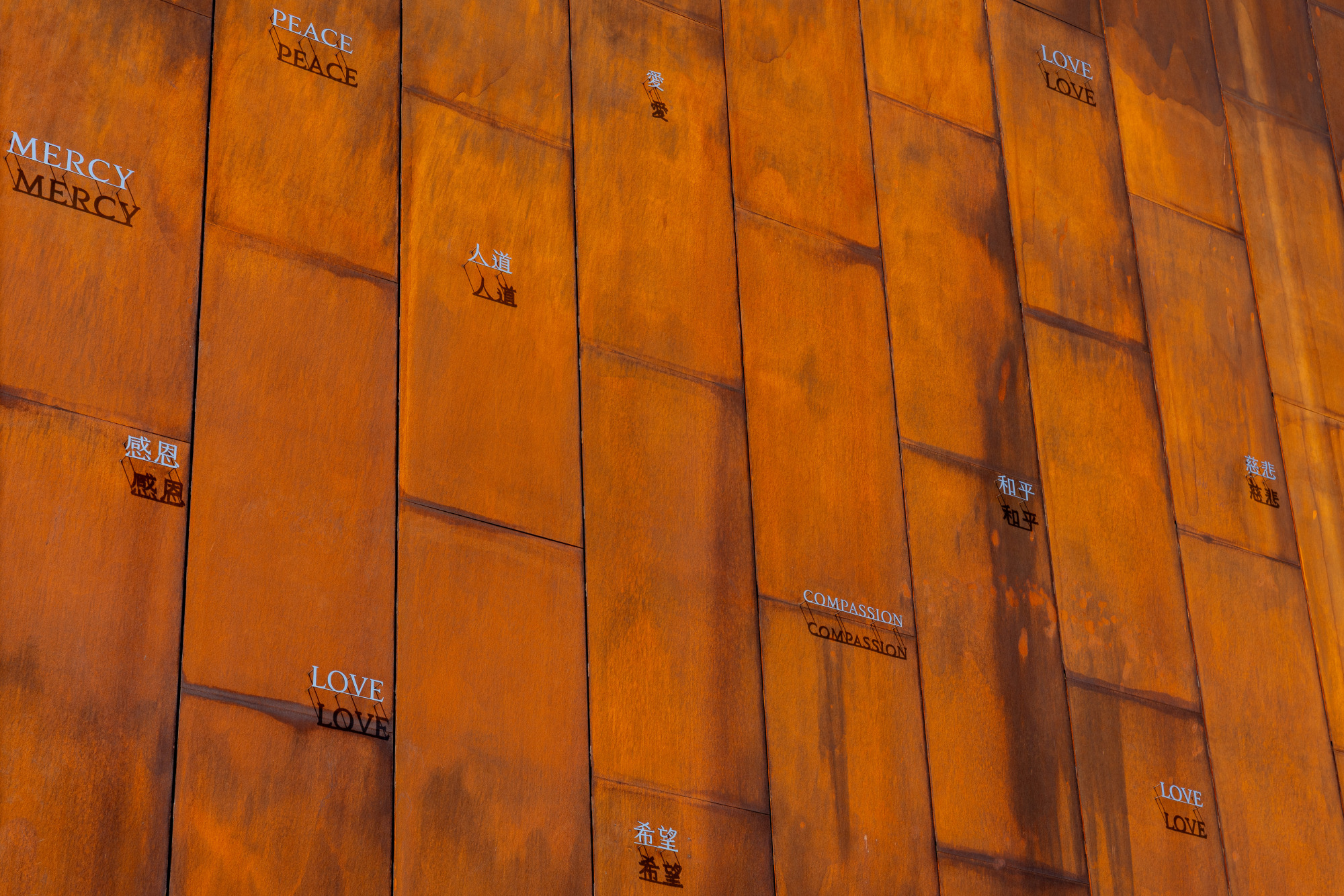
In Paul Chiang: Art Can Purify the Soul, author Chin-Hsun Wu describes the design of the third gallery’s exterior wall, “When morning sunlight shines upon it, the stainless-steel characters reflect like glimmers of light seen from afar, they flicker like starlight; viewed up close, the words become legible, like a Meditation on Eternity suspended between heaven and earth.”
In contrast, the sculpture Virtual and Real faces away from the east. At dawn, it disappears into the blinding brightness, its outline blurred. Only in the afternoon, when sunlight spills westward over the mountains, do its details slowly emerge. Whether in light or shadow, it quietly conveys Chiang’s enduring hope for light, nature, and for the silent beauty of stillness.
Paul and Henry
In the center of the plaza, Paul and Henry stands tall in vivid yellow. If Henry, exhibited at the Taitung Art Museum, was created for his grandson at age three, then Paul and Henry, completed two years later, is a continuation of that memory – an expression of their bond now that Henry has turned five. Parts of this sculpture reuse components from the original Henry, combined with pieces collected from the construction site during the center’s building phase – iron sheets, rods, and various leftover materials pieced together like a woven dialogue between time, space, and familial love.
“I remember the largest arc in Paul and Henry spans five meters in diameter,” Chiang recalls. From the outset, he envisioned that these large sweeping curves would bring a sense of movement to the sculpture, creating an open and liberated spatial presence. The emotional intimacy embedded in this work gives it a fearless, innocent, and freely expansive posture.
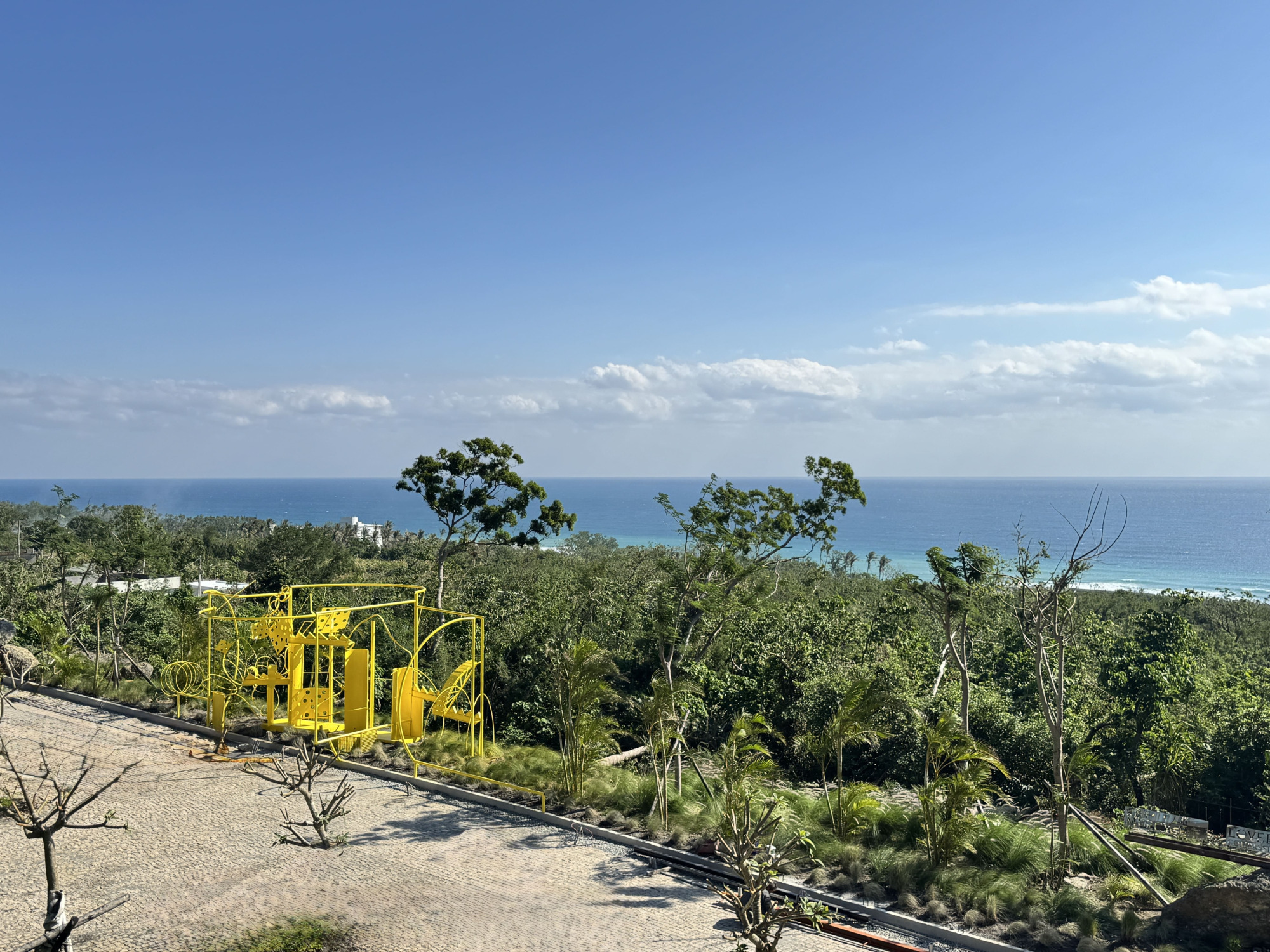
Why choose such an intense shade of yellow? Chiang explains, “Whether it’s gray, black, or yellow, my colors must carry a sense of purity. When I say ‘pure,’ I mean a kind of transparency. Some might not understand it, but I want the viewer to feel that the color is radiant, luminous, and clear.” He adds, “In fact, every color I use is one you can see every day in Jinzun. What we create are artworks, not nature itself, but these colors, they all come from nature.”
Afternoon of the Faun 25-01
The outdoor sculpture Afternoon of the Faun 25-01 is located in the midsection of the art center, composed of rows of vertical steel pipes in shades of teal and blue-green. As visitors approach, their eyes are easily drawn to the upright lines. Chiang says the idea for this work emerged from long periods of observing the site, accumulating impressions from viewing angles, backgrounds, and changing light from the southeast and northwest eventually giving rise to its form.
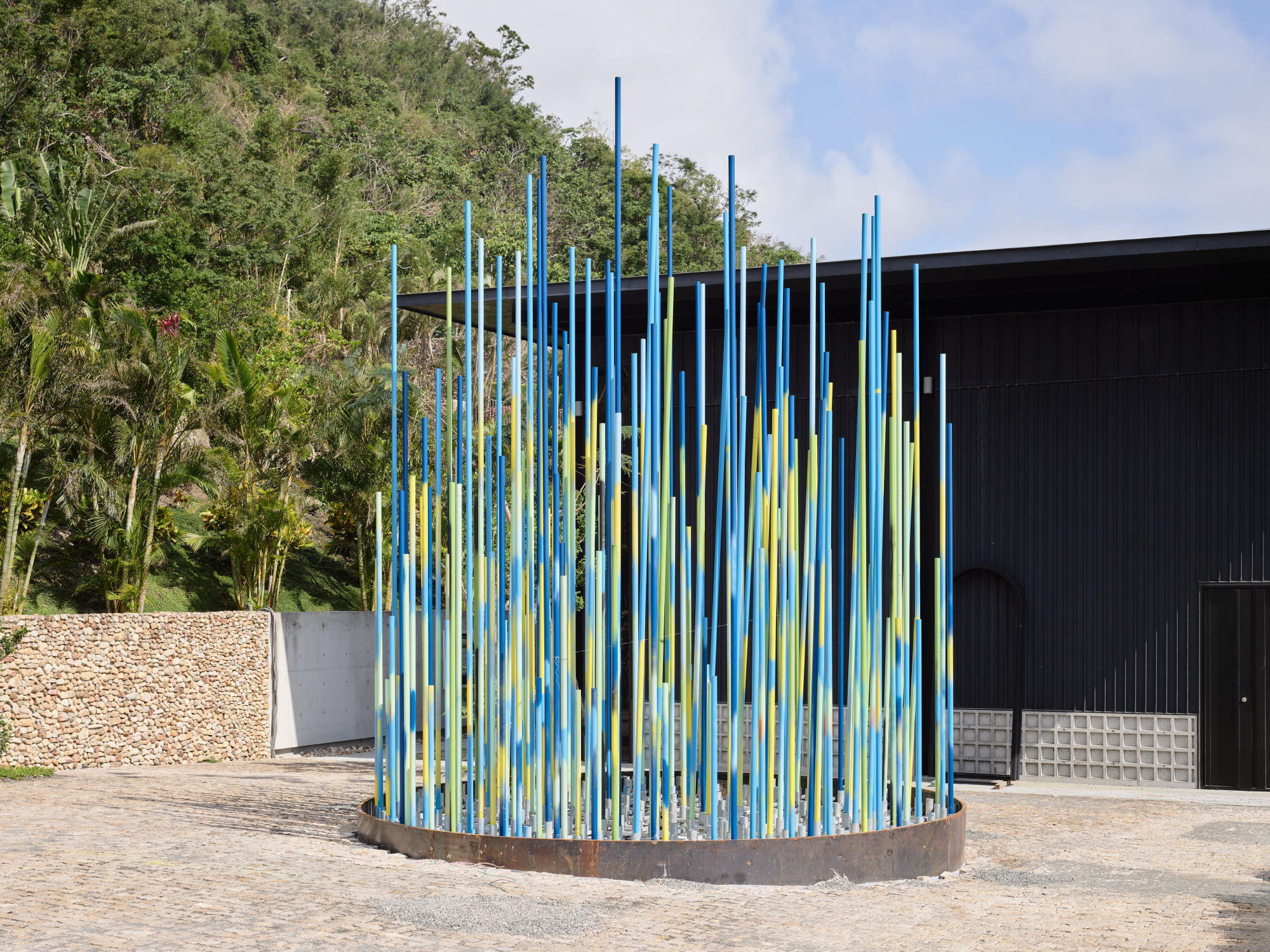
“The art center’s natural surroundings are already incredibly beautiful,” Chiang says, “but from an aesthetic perspective, most lines in nature are curved and irregular. Apart from the horizon, there are very few perfectly straight lines.” He emphasizes that when creating Afternoon of the Faun 25-01, he insisted that each steel pipe be installed with precise vertical and horizontal alignment. This kind of manmade order is his way of conversing with nature, making the work appear as though it belongs to the landscape, while simultaneously declaring itself as a work of art. Like a painting hung on a wall, no matter the colors used, it is meant to be seen.
As people gently pass through the alternating teal and blue-green pipes, the edges of their clothing may lightly brush against the steel, producing crisp, tinkling sounds of ding ding dong dong like scattered musical notes. Perhaps this wasn’t something Chiang originally intended, yet it adds an impromptu melody to the piece blending with the cicadas’ afternoon chorus, as if the faun is hidden in the woods, playing a carefree tune on his flute.
From the organic fusion of Virtual and Real, to the childlike joy and strength of Paul and Henry, and the vertical steel pipes establishing clear order in Afternoon of the Faun 25-01, these three sculptures embody Chiang’s ongoing dialogue with space and materials in the natural world.
“To be human, even just once, is truly wonderful.” – Paul Chiang
From five in the morning until six or seven in the evening, the light, wind, and colors within the art center are constantly changing. The sculptures transform throughout the day, revealing different aspects of themselves. “It’s endlessly shifting,” Chiang says. “At different times, with different light and wind directions, the sculptures never look the same.”
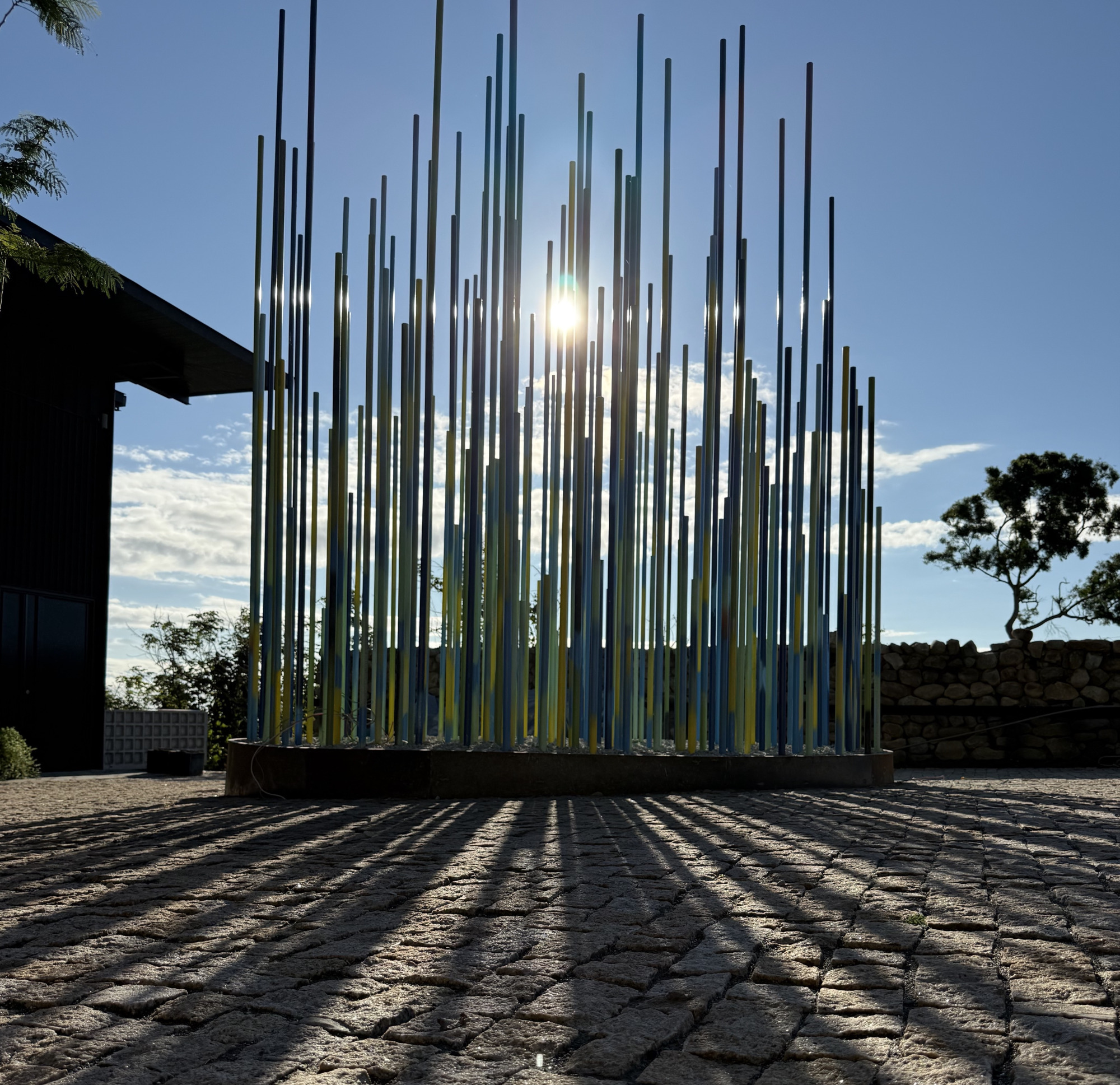
On the north side of the center, Phase II construction is currently underway in full swing. The area is set to become a sculpture park – an extension of Chiang’s long-standing passion for three-dimensional art. Nearly every other day, he personally walks the grounds, observing the site and reflecting on how the next piece should come to life, how it might engage in conversation with the land. “From ancient times to today, humanity has always expressed ‘beauty’ in similar ways through music, poetry, literature, architecture, film…” Chiang says. “Someday, I hope that when people look at me or write about me, they won’t categorize me so rigidly. All of these things are art. They all can move the human heart. My materials and forms may differ, but ultimately, I walk the same path.”
More than anything, he hopes that everyone who steps into the art center, whether pausing to admire a sculpture or simply watching blades of grass sway in the breeze, will come away with a sense that, “Life is, in truth, a beautiful thing. Though the world holds its share of pain, let nature take its course. To live even once and live it well is more than enough.”
“I inscribed ‘Humanity, Compassion, Love’ above the third gallery. That’s my heartfelt wish,” Chiang shares. He believes this belief can be passed on. All it takes is to move slowly, and keep walking in that direction.